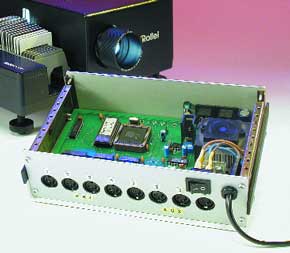MIDI Lights & Slide Control
controlling slide projectors with MIDI commands

This is a MEMBER ONLY article. You need a subscription to read this article.
- Unlimited access to online Member Only articles
- 3 new editions Elektor Magazine (digital)
- More than 5000 Gerber files
- 20% member discount on e-books (at elektor.com)
- 10% member discount on Products (at elektor.com)
Available from €5.33 per month.
What is Members Only
Elektor is committed to providing high-quality content on electronics, catering to tens of thousands of paying members. As part of this commitment, Elektor has launched Premium, an initiative that offers exclusive online articles to members sometimes even before they appear in the magazine.
Every day, members can access in-depth articles that showcase the best of Elektor's premium content.
This initiative aims to reward members with early access. Once logged in, members can easily enjoy this exclusive content and engage in discussions about featured projects. While Premium adds to the existing resources available, Elektor will continue to provide a wealth of free information.
Join the Elektor community today to take advantage of Premium and other benefits!
Materials
Gerber file
CAM/CAD data for the PCB referred to in this article is available as a Gerber file. Elektor GREEN and GOLD members can exclusively download these files for free as part of their membership. Gerber files allow a PCB to be produced on an appropriate device available locally, or through an online PCB manufacturing service.
Elektor recommends the Elektor PCB Service service from its business partner Eurocircuits or AISLER as the best services for its own prototypes and volume production.
The use of our Gerber files is provided under a modified Creative Commons license. Creative Commons offers authors, scientists, educators and other creatives the freedom to handle their copyright in a more free way without losing their ownership.
Extra info / Update
Component list
(All resistors SMD case # 1206)
R1,R2,R31 = not fitted
R3 = 150 Ohm
R4,R6,R9,R10,R35-R38 = 1k Ohm
R5,R25 = 220 Ohm
R7,R8,R12,R13 = 10k Ohm
R11 = 270k Ohm
R14 = 2k Ohm 2
R15 = 4k Ohm 7
R16 = 8k Ohm 2
R17,R18,R22,R24 = 82 Ohm
R19-R21,R23 = 680 Ohm
R26,R40...R43* = 100k Ohm
R27-R30=VDR 48-96 V, e.g., Siemens S10K50 or S07K50
R32,R34 = 270 Ohm
R33 = 100 Ohm *
P1 = 5k Ohm preset, 'ordinary' vertical model or Bourns type 3386
Capacitors:
C1,C2,C20 = 2nF2
C3,C13 = 33pF
C4,C9 = 10µ F 16V radial
C5,C6,C7,C14-C19 = 100nF, lead pitch 5mm
C8 = 1000µ F 25V radial
C10,C11 = 1µ F 16V radial
C12 = 3nF3
C14 = 100pF
Semiconductors:
D1,D4-D7 = LL4148 (SMD)
D2,D3 = 1N4001
D16 = LED, green
D17 = LED, yellow
IC1,IC8,IC9,IC10 = MOC3020 (QT, formerly Motorola: www.qtopto.com)
IC2 = 7805
IC3 = PC900 (Sharp)
IC4 = LM339
IC5 = 555
IC6 = SAB80C535-N
IC7 = 74HC573
IC11,IC12 = ULN2803
IC13,IC16 = 74HC4049
IC15 = 27C256, programmed, order code 000179-21
Miscellaneous:
K1-K10 = 5-way DIN socket, PCB mount, pjns arranged at 180°
K11 = 15-way sub-D socket (female), PCB mount, angled pins*
K12 = 2-way PCB terminal block, lead pitch 7.5 mm
X1 = 12 MHz quartz crystal
F1 = fuse, 100 mAT (time lag), with PCB mount holder
S1 = 4-way DIP switch
T1 = mains transformer, sec. 2 x 9 V/ 4.5VA (e.g., Monacor/Monarch VTR4209)
JP1 = 2-way pinheader
68-pin PLCC socket
Heatsink for IC2, e.g., SK104-50 (Fischer, Dau Components)
Re1-Re8 = 12-V relay (e.g., Zettler AZ5Y-1C-12DE or Siemens V23101-D6-A201
Enclosure type LC650 (Eurodis, Bolton)
PCB, order code 000179-1
Disk, contains sourcecode and binary file, order code 000179-11
* optional, for extensions



Discussion (0 comments)